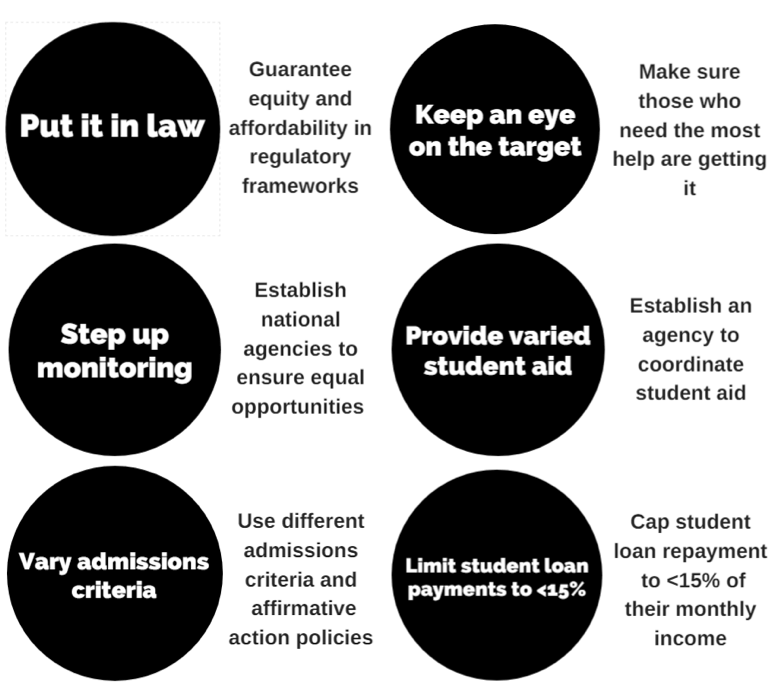Evidence-based policies for equity and affordability
By Taya Owens, GEM Report, and Michaela Martin, IIEP–UNESCO
The number of students around the world has exploded. It has doubled in just over a decade to reach 207 million in 2014. It is therefore no wonder that governments are scrambling to catch up.
Fast expansion, as seen in primary education when fees were abolished, is something that will strain any system. And higher education has strong requirements of the most advanced and specialised human resources. It is understandable that governments cannot easily figure out new ways of footing the bill in higher education. Meanwhile, that bill falls to households, many of whom can’t afford it.
The trends in access to higher education since 2000 have been analysed in depth by our teams at the Global Education Monitoring (GEM) Report and at the International Institute for Educational Planning in a new Policy paper.
Both our teams are based at UNESCO, the only UN organisation with responsibility for higher education. Our focus on the affordability and equitability of higher education is driven by the new UN Sustainable Development Agenda, and the Education Agenda 2030 in particular, the first time that higher education has a mention in global development goals. The urgency behind our recommendations comes from the evidence our research uncovered showing the extent to which the disadvantaged are being left behind in many countries.
Our new paper, Six ways to ensure higher education leaves no one behind, shows profound gaps in how different groups of students are able to participate in higher education. We also give concrete recommendations to help governments meet their commitments.
This paper offers a new insight into the lags in equity through a unique dataset compiled by the GEM team. Currently, only one per cent of the world’s poorest have completed at least four years of college, compared to 20 per cent of the richest. In the most extreme case, in the Philippines, the richest are 50 times more likely to have four years under their belts than the poorest.
Disadvantaged groups are also missing out. In Mexico, less than one per cent of the indigenous population attend higher education. Similarly, in South Africa, around a sixth of Africans and Coloureds attended higher education in 2013, compared to over half of whites. In China, youth from rural areas are seven times less likely to attend university than students from urban areas.
And there are still notable gender disparities as well in some places. Women made up only 30 per cent of bachelor students in low-income countries in 2014.
Gender disparities also get much more visible on average across all countries as you start looking at PhD programmes. On average, while more women than men enrol in higher education in the first place, they lag behind men (44 per cent) at this level, which still determines careers in many places.

Affordability is key to equitable access
While it doesn’t explain all of the disparities, part of the reason for some disadvantaged groups being left behind is without doubt financial; governments simply can’t afford to pay for the sheer number of new students, and this is leaving households footing the bill.
Across 26 countries in Europe, for example, households paid 15 per cent of the cost of higher education in 2011. In other high-income countries, this rose even higher: to 40 per cent in Australia, 46 per cent in the USA, 52 per cent in Japan, 55 per cent in Chile. The cost of attending university in China for the poorest households is 187 per cent of their annual income. It is not a stretch to say that the cost of higher education is becoming a ball and chain for some students.
One approach to affordability is to make higher education free for all. In the face of rising costs, ‘free’ sounds to many students and families like exactly the right position. For that reason, free tuition is a hot topic in Germany, South Africa and the United States. However, a free-for-all tuition policy that does not go along with additional support for disadvantaged groups can exclude poor students and subsidise the rich.
In Argentina, for example, public universities have free tuition, but almost 90 per cent of students at these institutions have per capita family income that is higher than the median, and almost 50 per cent attended tuition-financed private high schools. So, to increase equity, any effort to keep tuition fees low at public universities has to happen in conjunction with pathways for admission for talented students from disadvantaged backgrounds and financial aid programmes for all.

Diverse systems require diverse solutions
Our research showed that financial aid programmes combining grants, loans and tax benefits are essential to improve students’ ability to pay for higher education. One particular policy we explore in our paper is income contingent loans. Flexible repayment plans can be adjusted to match student’s household income across the life of the loan. We feel strongly that repayments should never go higher than the 15 per cent mark of any graduate’s monthly income.
Governments would do well to think about equity policies as building blocks that can help build more robust higher education systems. We have six specific recommendations that could help policymakers make higher education equitable and affordable for all. This diverse set of policies work hand in hand to offer different solutions for different needs.


